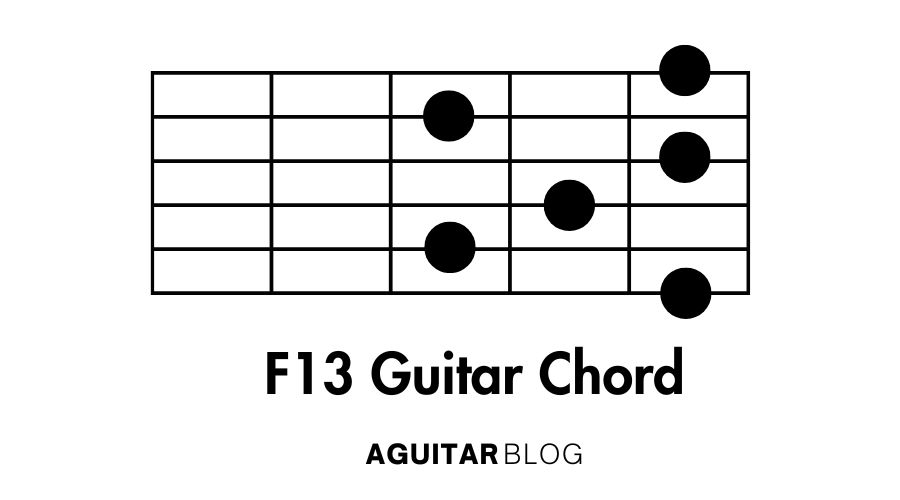Learn how to play the F13 guitar chord with this in-depth guide. Includes step-by-step instructions, variations, tips for clean transitions, and its role in jazz, blues, and funk progressions.
What is an F13 Guitar Chord?
The F13 chord (F Thirteenth) is an extended dominant chord that brings a rich, jazzy sound to your playing. It’s built from an F7 chord with additional notes: the ninth (G), eleventh (Bb), and thirteenth (D). This chord is widely used in jazz, blues, and funk to add color and sophistication to progressions.
The notes in the F13 chord are:
- F (Root)
- A (Major third)
- C (Perfect fifth)
- Eb (Minor seventh)
- G (Ninth)
- D (Thirteenth)
How to Play the F13 Guitar Chord

Common F13 Shape (Root on 6th String):
- Place your index finger on the 1st fret of the low E string (F note).
- Place your middle finger on the 1st fret of the B string (D note).
- Place your ring finger on the 2nd fret of the D string (Eb note).
- Place your pinky finger on the 3rd fret of the G string (A note).
- Strum the E, D, G, and B strings while muting the A and high E strings.
Simplified F13 Shape (Partial Voicing):
- Place your index finger on the 1st fret of the low E string (F note).
- Place your middle finger on the 2nd fret of the D string (Eb note).
- Place your ring finger on the 2nd fret of the G string (A note).
- Strum only the low E, D, and G strings.
Video Tutorial
Learn the F13 chord with step-by-step visuals for both basic and advanced shapes.
Common Mistakes and Tips for Playing the F13 Guitar Chord
Common Mistakes:
- Muting the Wrong Strings: Be cautious about accidentally muting the strings needed for the chord.
- Overplaying Notes: Avoid strumming the A string or the high E string unless intentionally adding extensions.
- Improper Finger Stretching: The shape requires flexibility, so skipping warm-ups can make the chord harder to play.
Tips for Success:
- Focus on the Core Notes: Start with the root, seventh, and thirteenth to simplify your voicing.
- Relax Your Hand: Avoid tension in your fretting hand to prevent fatigue during extended play.
- Practice Barre Chords: Strengthen your fingers with barre chords to make the F13 easier to master.
Variations of the F13 Guitar Chord
- F13 (No Fifth): Omits the C note for a more open sound.
- F13 Add9: Includes the ninth (G note) for an enriched tone.
- F13 (Rootless Voicing): Common in jazz, where the bassist plays the root note, leaving the guitarist to focus on the upper extensions.
Chord Progressions and Songs Featuring the F13 Guitar Chord
Common Chord Progressions:
- F13 – Bb13 – C7: A standard blues progression with rich voicings.
- F13 – Gm7 – C13: Popular in jazz and swing styles.
- F13 – D7 – G7: Adds tension and resolution for funk and blues jams.
Songs Featuring the F13 Chord:
- “The Thrill Is Gone” by B.B. King: A blues classic that utilizes extended dominant chords.
- “Chameleon” by Herbie Hancock: Funk grooves with F13-like voicings.
- “Autumn Leaves” (Jazz Standard): Extended chords like F13 enhance its harmonic richness.
Tips for Practicing the F13 Guitar Chord
- Break It Down: Practice the basic F7 chord first, then add the 13th note.
- Use a Metronome: Incorporate F13 into progressions at a slow tempo to improve transitions.
- Experiment with Rhythm: Strum or pick the F13 chord in various rhythms to explore its dynamic potential.
Related Chords to the F13 Guitar Chord
- F7: The foundation of the F13 chord, containing the root, third, fifth, and seventh.
- F9: Includes the ninth (G) but omits the eleventh and thirteenth.
- F11: Adds the eleventh (Bb) to F7, without the thirteenth.
- Bb13: Commonly paired with F13 in blues and jazz progressions.
The F13 chord is a versatile addition to your chord vocabulary, offering a sophisticated sound that’s perfect for advanced blues, jazz, and funk progressions. Keep practicing, and unlock its harmonic potential!